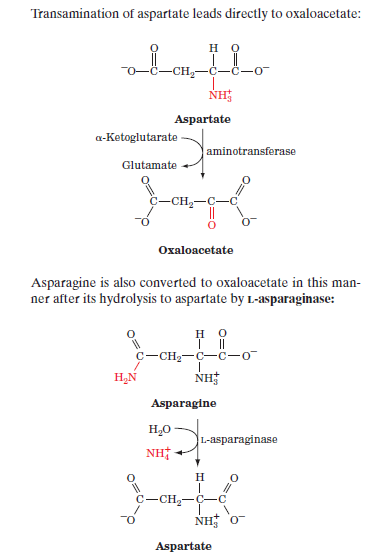“Standard” amino acids are degraded to one of seven metabolic intermediates: pyruvate, α-ketoglutarate, succinyl-CoA, fumarate, oxaloacetate, acetyl-CoA, or acetoacetate.
The amino acids may therefore be divided into two groups based on their catabolic pathways:
- Glucogenic amino acids;
- whose carbon skeletons are degraded to pyruvate, α-ketoglutarate, succinyl-CoA, fumarate, or oxaloacetate and are therefore glucose precursors.
- Ketogenic amino acids;
- whose carbon skeletons are broken down to acetyl-CoA or acetoacetate and can thus be converted to ketone bodies or fatty acids.
The amino acids degraded to acetyl-CoA and acetoacetyl-CoA are used in the citric acid cycle, but mammals cannot synthesize glucose from acetyl-CoA. This fact is the source of the distinction between glucogenic and ketogenic amino acids. Glucogenic amino acids can be converted to glucose, with oxaloacetate as an intermediate, but ketogenic amino acids cannot be converted to glucose.
Strictly speaking, whether an amino acid is regarded as being glucogenic, ketogenic, or both depends partly on the observer. This classification is not universally accepted, because different quantitative criteria are applied will identify the degradation pathways by the entry point into metabolism.
I would also attribute to things like availability of feasible pathways, enzymes etc (for instance alanine is glucogenic because its transamination product, pyruvate can be converted to glucose via gluconeogenesis)
Some amino acids have more than one pathway for catabolism, which explains why four of the amino acids are listed as both glucogenic and ketogenic examples are Isoleucine, phenylalanine, threonine, tryptophan, and tyrosine)n:
Below I will include snippets of degradation products of named amino acids:
- Five amino acids, alanine, cysteine, glycine, serine, and threonine, are broken down to yield pyruvatenpyruvate:
- Asparagine and Aspartate Are Degraded to Oxaloacetate:
- Arginine, Glutamate, Glutamine, Histidine, and Proline Are Degraded to α-Ketoglutarate:
The reason I included these pathways, is to allow you to visualise structure, feasible metabolic pathways and enzymes so you have a clear picture on the differences between these amino acids.
And so on..
Hope this helps..
References
Voet and Voet biochemistry J.Berg Biochemistry Campbell and Farrel Biochemistry




